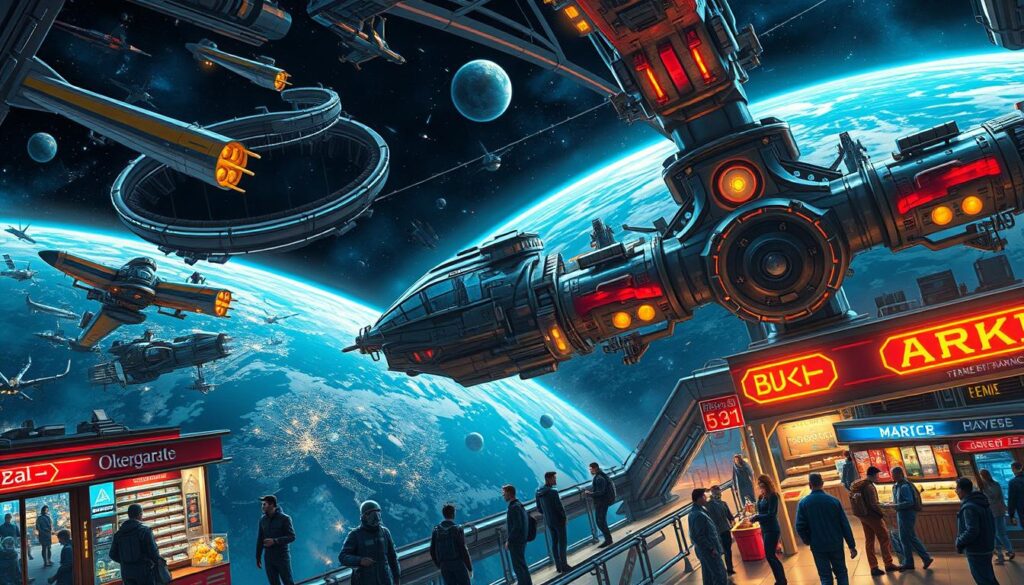“As an Amazon Associate I earn from qualifying purchases.” .
As a kid, I used to look at the stars and dream of floating among them. Now, that dream is coming true. Commercial space travel is real and changing how we see the universe. We’re starting a new era where space is open to adventurers like us.
Space tourism captures our hearts. Imagine looking down at Earth from space. It’s a view that changes lives, and it could change yours soon. The space tourism market is expected to grow to $3 billion by 2030. It’s not just for fun; it’s about exploring beyond our planet.
Private companies are leading the way in space exploration. They’re building and running space systems. NASA is working with them, changing how we explore space. In 2020, we saw history as the first commercial crewed flight reached the International Space Station. This is just the start of what’s possible with innovation and space dreams.
There are many exciting experiences in space, from balloon trips to astronaut training. You can choose from suborbital flights to staying in space. We’re not just watching – we’re pioneers in a new space age.
Key Takeaways
- Commercial space travel is now a reality, with 51 people having flown on commercial vehicles to low Earth orbit.
- The global space tourism market is projected to reach $3 billion by 2030.
- NASA is partnering with private companies to develop commercial space stations.
- Space tourism experiences range from suborbital flights to potential future lunar visits.
- The first crewed commercial flight to the International Space Station took place in 2020.
The Dawn of a New Era: Commercial Space Travel
Space travel has always sparked our dreams. Now, it’s becoming real for regular people. Commercial space travel is changing how we explore the universe.
Defining Commercial Space Travel
Commercial space travel offers a range of experiences. From short Suborbital Flights to longer Orbital Spaceflights. The Kármán line, 60 miles up, marks space. Companies are offering unique trips beyond this line.
Key Players in the Industry
Three companies are leading in commercial spaceflight:
- Virgin Galactic: Flights reach about 53 miles high
- Blue Origin: Flights go over 62 miles
- SpaceX: Ventures beyond 120 miles
Each company has its own space tourism vision. Virgin Galactic focuses on suborbital flights. SpaceX aims for orbital missions and beyond. Blue Origin offers both suborbital and orbital trips.
The Growing Market for Space Tourism
Space tourism is now a reality. Since Dennis Tito’s historic trip in 2001, the industry has grown fast. Now, many companies offer space experiences. From short moments of weightlessness to long stays in orbit, there are many options for space fans.
As technology gets better, we’re entering a new era of space exploration. Commercial space travel is more than just tourism. It’s about fueling curiosity about science and technology. It’s opening doors to new discoveries and pushing human limits.
| Company | Flight Type | Altitude (miles) |
|---|---|---|
| Virgin Galactic | Suborbital | 53 |
| Blue Origin | Suborbital/Orbital | 62+ |
| SpaceX | Orbital | 120+ |
The future of space travel looks bright. With more companies joining, prices will drop and more opportunities will open up. Soon, going to space might be as easy as flying across the ocean.
The Low Earth Orbit Economy: A Booming Market
We’re in an exciting time with the Low Earth Orbit Economy taking off. This market is changing how we do business in space, offering new chances for both business and science.
LEO, the area less than 1,200 miles above Earth, is alive with action. It hosts over 90% of satellites and the International Space Station (ISS). This makes it a key spot for space businesses.

NASA started the Commercial Low Earth Orbit Development Program in 2019. Its goal is to grow the LEO economy. NASA plans to move from being the main player to just one of many customers in this growing market.
The growth in this field is huge. The space economy has grown by over 60% in ten years and is now worth about $400 billion. This growth is thanks to private companies making new spacecraft and launch systems.
| Program | Objective | Impact |
|---|---|---|
| Commercial Resupply | Develop next-gen spacecraft | Multiple companies involved |
| Commercial Crew | Develop new launch systems | Enhancing space access |
| Private Astronaut Missions | Enable commercial ISS visits | Boosting space tourism |
Looking ahead, the Low Earth Orbit Economy will change industries, drive tech growth, and open space for more businesses and people. It’s a thrilling time for space exploration, with many new possibilities ahead.
From Earth to Space: How Commercial Space Travel Works
Commercial space travel is changing how we reach the stars. Now, Reusable Launch Vehicles make Space Tourism cheaper and more common. Let’s dive into the exciting ways that are bringing space closer to us.
Rocket-Powered Flights
Rocket-powered flights are key to commercial space travel. Companies like Blue Origin and Virgin Galactic are leading the way with Suborbital Flights. These short trips give you a taste of weightlessness and leave lasting memories.
Balloon-Assisted Space Travel
Balloon-assisted space travel offers a smoother ride to the sky. World View’s pressurized capsule goes up to 100,000 feet, giving you a special view of Earth. These trips last 6 to 12 hours and cost about $50,000, making space more reachable.
Suborbital vs. Orbital Experiences
Suborbital Flights take you to the edge of space quickly. Orbital flights let you stay in Earth’s orbit longer. SpaceX is a leader in orbital flights, expanding Space Tourism. Your choice depends on how much adventure you want and your budget.
| Experience Type | Duration | Approximate Cost |
|---|---|---|
| Suborbital Flight | Minutes | $250,000 – $500,000 |
| Balloon-Assisted | 6-12 hours | $50,000 |
| Orbital Flight | Days | Tens of millions |
As technology gets better, prices are going down. A NASA report says space travel could be as low as $50,000 or $10,000 in a decade. With these prices, up to 500,000 people could go to space every year. Affordable space travel is becoming a reality, opening up a new space economy.
Pioneering Companies Shaping the Future of Space Tourism
We’re entering a new era of space exploration. Companies like Virgin Galactic, Blue Origin, and SpaceX are leading the way. They’re making space travel a reality for us all.
SpaceX was started by Elon Musk in 2002. They’ve created the Falcon Heavy, the strongest rocket in use today. In 2020, SpaceX made history by launching astronauts to the International Space Station for the first time.
Blue Origin, founded by Jeff Bezos, is exciting with its New Shepard rocket. They’ve taken famous people like William Shatner to space. They plan to launch the New Glenn rocket for trips to orbit, making space more accessible.

Virgin Galactic offers suborbital flights for $450,000. They use a rocket and a special aircraft for a unique experience. These companies are changing the game in space, creating a new economy and inspiring others.
| Company | Founded | Key Achievement | Future Goal |
|---|---|---|---|
| SpaceX | 2002 | First private crewed orbital launch | Self-sustaining city on Mars |
| Blue Origin | 2000 | Suborbital tourism flights | Lunar colonization |
| Virgin Galactic | 2004 | Unique air-launched spaceplanes | Regular suborbital tourism |
These pioneers are doing more than just offering space tours. They’re pushing tech forward, creating new industries, and inspiring the next generation. The future of space travel is thrilling, and it’s here now.
The Spaceship Neptune Experience: Redefining Space Travel
We’re stepping into a new era with Spaceship Neptune. This spacecraft is changing how we travel to space. It combines safety, luxury, and sustainability in a unique way.
Safety and Accessibility
Spaceship Neptune is setting new safety standards for space travel. Its spherical capsule is 16 feet wide, giving over 2,000 cubic feet of safe space. It has a backup system with four parachutes for a secure trip for eight Explorers and a Captain.
Luxurious Amenities in Space
Spaceship Neptune takes space tourism to new heights of comfort. It has the biggest windows ever seen in space, giving amazing views. Passengers get Wi-Fi, gourmet food, and even a space spa. The six-hour trip costs $125,000 per seat, making it an unforgettable adventure.
Carbon-Neutral Space Flight
Spaceship Neptune is leading the way in sustainable space travel. It runs on renewable hydrogen, making it the first carbon-neutral flight for humans. This focus on the environment sets a new standard in space innovation.
| Feature | Spaceship Neptune |
|---|---|
| Capsule Diameter | 16 feet |
| Pressurized Volume | 2,000+ cubic feet |
| Passenger Capacity | 8 Explorers + 1 Captain |
| Flight Duration | 6 hours |
| Ticket Price | $125,000 per seat |
With over 1,750 tickets already sold, Spaceship Neptune is starting a new chapter in space tourism. It’s combining safety, luxury, and sustainability in a way that’s changing commercial space travel.
NASA’s Role in Fostering Commercial Space Travel
NASA is key in shaping the future of commercial space travel. We’re entering a new era where NASA works with private companies to explore beyond Earth. This partnership is changing space travel and opening new doors for science and tourism.
The space agency is boosting a strong commercial space economy. American companies are now vital in keeping us in space. NASA’s plan is to help private companies build and run space systems. This is making innovation grow and costs go down in private space exploration.
Low Earth Orbit (LEO) is now a key area for commercial space work. It’s the area from 100 to 1,200 miles above Earth, perfect for transport, communication, and watching the Earth. The LEO economy is growing fast, with more goods and services being made and traded in space.
“NASA aims for a sustainable presence in space and leads initiatives for commercial space activities.”
Private astronaut missions are becoming more popular. These are trips to the International Space Station paid for by private companies. NASA helps with planning and support, but private astronauts must follow FAA rules.
| Aspect | Details |
|---|---|
| NASA’s Role | Enabling private industry, purchasing services for science and research |
| LEO Economy | Production, distribution, and trade of space-related goods and services |
| Private Astronaut Missions | Privately funded flights to ISS, up to 30 days |
| Intellectual Property | Retained by partners under NASA contracts |
NASA is really pushing for commercial space travel through its partnerships and rules. By working with the private sector, NASA is speeding up space tech development. This brings us closer to a future where space travel is for more people.
The Lunar Economy: The Next Frontier
The Lunar Economy is growing fast in the world of Commercial Space Travel. As we aim for the moon, new chances for exploration and business are coming up. NASA’s Artemis program is leading the way to bring humans back to the moon. This will open up new areas in Space Tourism.
Commercial Lunar Payload Services
NASA is working with American companies to innovate in lunar exploration. The Commercial Lunar Payload Services is creating a strong market on the moon. These partnerships are key for sending science and technology to the moon, starting in 2023.
The space industry has grown a lot, increasing by over $200 billion recently. It could hit $1 trillion by 2030, showing the big potential of the Lunar Economy. This growth is drawing in experts from many fields, like STEM, IT, and government.
Future Prospects for Lunar Tourism
Lunar Tourism is an exciting new area in Space Tourism. NASA plans to send a human crew to the moon by 2025 with the Artemis mission. This is sparking excitement around the world. Over two dozen companies are now working on lunar missions, showing strong investor interest.
Lockheed Martin’s new venture, Crescent Space, is a big step in lunar infrastructure. It aims to solve the problem of keeping communication lines open between Earth and the moon. With their Parsec network launching in 2025, we’re on the edge of a new chapter in lunar exploration and tourism.
Preparing for Your Space Journey: What to Expect
Space tourism is now a reality. Commercial space travel is changing how people get ready for these amazing trips. Whether it’s a short suborbital flight or a longer space stay, here’s what you should know about preparing.
For suborbital flights, training is short. Companies like Virgin Galactic and Blue Origin prepare you in a few days. They teach you about safety and how the spacecraft works. You’ll also get to try out weightlessness and learn how to move in space.
Longer space trips need more training. NASA’s astronaut program shows what’s involved. Trainees go through two years of hard training before flying. This includes:
- 300 hours in simulators
- 10 hours underwater training for every hour of spacewalk
- Extensive flight training in T-38 jets
- Physical conditioning to counteract muscle and bone loss in microgravity
Commercial space travelers get some of this training, but it’s not as intense. You’ll try zero-gravity flights and underwater simulations to get ready for space. It’s important to know about G-forces during launch and reentry. Also, learning how to do everyday tasks without gravity is key.
“Space travel is not just about the destination, it’s about the journey of preparation that transforms you into an explorer of the cosmos.”
| Activity | Government Astronauts | Commercial Space Travelers |
|---|---|---|
| Initial Training | 2 years | Few days to weeks |
| Physical Preparation | Extensive | Basic fitness |
| Weightlessness Training | Underwater + Zero-G flights | Zero-G flights |
| Mission Duration | Months to a year | Minutes to days |
Even though training for commercial space travel is less intense, it’s still important for your safety and to make your trip better. As you get ready for this amazing journey, you’re not just a tourist. You’re becoming a space explorer.
The Impact of Commercial Space Travel on Science and Technology
Commercial space travel is changing science and technology. It has led to big discoveries in space and on Earth. Let’s see how this exciting field is making our future better.
Advancements in Aerospace Engineering
The Commercial Space sector is making huge strides in aerospace engineering. Companies like SpaceX are improving rocket technology. They’re making launch systems reusable, which cuts costs a lot. This opens up new chances for exploring space and sending satellites.
- Commercial space activity tripled from $110 billion to $357 billion between 2005 and 2020.
- Small satellite launches went from 53 in 2017 to 1,743 in 2021.
- Now, the space industry has over 10,000 private companies and 5,000 big investors.
Spin-off Technologies for Everyday Life
Commercial Space ventures bring more than just space benefits. Many space technologies help us in our daily lives. They improve things like healthcare, transport, and how we watch the environment.
| Space Technology | Everyday Application |
|---|---|
| Satellite imaging | Weather forecasting, GPS navigation |
| Water purification systems | Clean drinking water in remote areas |
| Memory foam | Mattresses, pillows, shoe insoles |
| Scratch-resistant lenses | Eyeglasses, sunglasses |
As Private Space Exploration grows, we’ll see more amazing Aerospace Innovations. These will shape our future and make life on Earth better.
Conclusion: Embracing the Space Age
We’re on the edge of a new era in exploring space. Commercial space travel is now a reality, not just a dream. With rocket and balloon flights, getting into space is easier than ever.
Space tourism is getting more popular, thanks to private companies. They’re making space travel possible for more people.
This new space age is about more than just the fun of floating in space. Since 1976, NASA says over 2,000 technologies from space have made life better on Earth. Small satellites now make up 94% of all space launches, changing how we use space technology.
These innovations are making space more reachable and changing industries on Earth.
Looking up at the stars, we must think about the right way to explore space. Space ethics is a growing field that asks big questions about our place in the universe. Even with challenges like safety and rules, the future of space travel looks bright.
We’re not just watching history happen; we’re making our own chapter in space exploration.
FAQ
What is commercial space travel?
Who are the key players in the commercial space travel industry?
What is the Low Earth Orbit (LEO) economy?
How does commercial space travel work?
What is the Spaceship Neptune experience?
What is NASA’s role in commercial space travel?
What is the Commercial Lunar Payload Services initiative?
What should I expect when preparing for a space journey?
How is commercial space travel impacting science and technology?
“As an Amazon Associate I earn from qualifying purchases.” .



